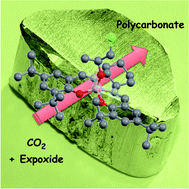Al complexes are widely used in a range of polymerization reactions (ROP of cyclic esters and cationic polymerization of alkenes). Since the discovery in 1978 that an Al porphyrin complex could copolymerize propylene oxide with carbon dioxide, Al coordination compounds have been studied extensively as catalysts for epoxide-carbon dioxide copolymerizations. The most widely studied catalysts are Al porphyrin and Al salen derivatives. This is partially due to their ability to act as mechanistic models for more reactive, paramagnetic Cr catalysts. However, this in depth mechanistic understanding could be employed to design more active Al catalysts themselves, which would be beneficial given the wide availability of this metal. Polymerization data (% CO3 linkages, Mn, Mw/Mn and TON) for these complexes are presented and mechanisms discussed. In most cases, especially those employing square-based pyramidal Al complexes, co-catalysts are required to obtain high levels of carbon dioxide incorporation. However, in some cases, the use of co-catalysts inhibits the copolymerization reaction. Lewis acidic Al phenolate complexes have been used as activators in CHO-carbon dioxide copolymerizations to increase TOF and this has recently led to the development of asymmetric copolymerization reactions. Given the ready availability of Al, the robustness of many complexes (e.g. use in immortal polymerizations) and opportunity to prepare block copolymers and other designer materials, Al complexes for copolymerization of carbon dioxide are surely worth a second look.

You have access to this article
 Please wait while we load your content...
Something went wrong. Try again?
Please wait while we load your content...
Something went wrong. Try again?


 Please wait while we load your content...
Please wait while we load your content...